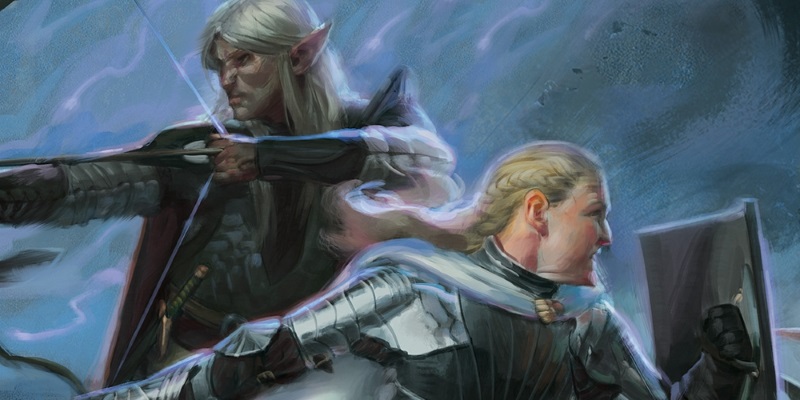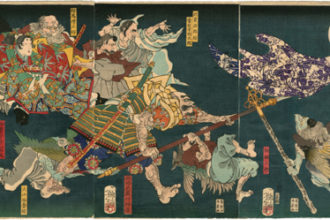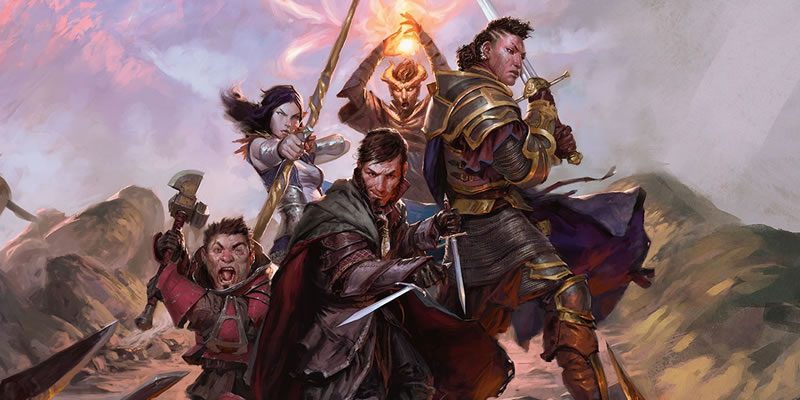Unearthed Arcana: Encounter Building Breakdown

Huh, new UA today, and on what is for some of us a holiday. I guess WotC doesn’t take Indigenous Peoples’ Day off? Either that, or they decided it should be a gift-giving holiday. Anyway, today Mearls is tackling an alternate approach to encounter building. Overall, we see very little expansion or revision of DM-facing content, and especially not with something as bone-dry as encounter building.
What Came Before
It’s fairly rare in discussing UA articles that one really needs to explain the situation that the article affects. In this case, though, I’m betting that:
- If you’re not a DM, you haven’t read the encounter-building section in any depth. Like I said, it’s some seriously dry text.
- If you are a DM, but don’t write adventures for a living (or as a sideline income, you know what I mean), I would give no better than 50/50 odds that you’ve read and grasped the encounter-building section.
- Only if you write adventures for pay would I find it likely that you’ve made a study of these rules. (I do, and haven’t, but maybe I’m an outlier.)
I can’t think of a way to collect scientific data on this, but… whatever. Not important right now.
The thrust of the rules is that experience points reflect creature power, and while it’s still in the DM’s hands, XP can be treated as a kind of fungible currency. The trick is figuring out your budget. The section starts with Sample Objectives, though, and my love of narrative salutes them for putting the encounter’s stakes before its mechanics.
The mechanics recognize four grades of encounters: Easy, Medium, Hard, and Deadly – thus, implicitly, they assume you know how tough of an encounter would make for satisfying narrative pacing at each stage of an adventure. There’s not a lot of guidance for that in the book, but most DMs learn from instinct over time anyway.
You start, then, with each character’s “XP Threshold,” taken from the appropriate difficulty column. (The UA article’s main thrust is to flip this specific part of the approach, so keep this in mind.) Add all of these numbers together; now you have the Party’s XP Threshold, which we might as well call the Encounter Budget.
Then things get weird, because this chapter is actually trying to support two trains of thought at the same time. On one hand, it has an approach for when you know the characters and the difficulty, but haven’t yet decided on the opposition. (Steps 1 and 2 of Evaluating Encounter Difficulty proceed logically from this position.) On the other, it assumes you know the opposition, but haven’t yet decided anything about the difficulty. (Steps 3 and 4 proceed from this state.) The book doesn’t tell you it’s doing this, exactly, so it sets you up for some awkward recalculation.
Fortunately, there’s a table called Encounter Multipliers, that more or less reflects the raw power of action economy. More monsters means more chance to hit, to pass saving throws – even to be taken out of the fight by crowd-control without just ending the fight; also more reactions, and more territory under threat of opportunity attacks. Now, it also means that AoE spells are not just better, they’re a lot better. If you did have a target difficulty in mind, this table helps you find it, but in a sort of trial-and-error way. There are also good guidelines small parties and encounters that unfold in waves.
D&D has always used attrition mechanics to pace out the adventuring day, so there’s also a chart of Adventuring Day XP – how much overall XP of Trouble a PC can face, which is then summed for the party. On one level, this is kind of painfully reductive – new DMs could get drawn into thinking that instructions on how to balance encounters means that every encounter should be balanced. (They shouldn’t. Encounters that are much too hard to be won are a good thing, used judiciously.) This kind of thinking pervaded 3.x, down to the point of adventure writers powergaming the enemy stat blocks to get as much murder potential out of a target CR as the rules allowed (“okay, so I’ll class-dip two levels of warrior…”) On the other hand, if you know when to use these numbers and when to ignore them, everything is fine.
Finally, there are a few brief sections of advice on how to make encounters memorable, more dangerous, and fun. For their brevity, there’s a ton of good advice here, and I would argue that these bullet points should be treated like an a la carte menu, from which you should really order at least one thing. Just to be polite, y’know. If you’re a blogger like me and you want a seriously underserved area of content to write about, expand these lists with more awesome ideas.
In with the New
This is a multi-step process, so I’ll tackle each step separately.
- Step 1 is about characters: note the levels of party members, and anything that renders them unusually strong or weak.
- This step indirectly reads: “This system is useless for DM’s Guild adventure writers.”
- Next you decide encounter size – how many creatures you want to include. Fortunately, the workflow here makes it easy to tweak your answer to this step later on.
- The document suggests using a legendary monster if you want a solo encounter, since that’s what they’re designed to do. That’s true as far as it goes, but I’m hearing a lot of reports from players and DMs that even legendary monsters with a CR 4-5 higher than the party are just not durable enough to get more than a round or so of attacks.
- This step is the crunchy part of this article. There’s a table for the CR of a suitable solo, followed by a table broken up into level brackets of five levels each. There’s a lot to say about this.
- First, the information is presented as ratios: 1:2, 3:1, and so on. The first number represents a PC of that row’s level (or more than one PC), while the second number represents one or more monsters of that column’s CR.
- It’s hard to understand how this information jives with the solo monster table – if you have a party of five 15th-level characters, the first table proposes a CR 19 creature with legendary powers, etc.; the second table proposes one CR 15 creature without legendary powers.
- There are some guidelines for how to shift the encounter into Easy, Hard, or Deadly mode. This section tells me, for sure, that I am accustomed to characters more powerful than WotC’s idea of normal. I think we need to have a real talk about the power-level difference that you get from various stat generation methods, or at least what WotC really sees as “normal.”
- Some of the ratios wind up with huge numbers of creatures, resulting in near-mass-combat encounters. 5th level characters against CR 1/8 gives you 1:12, so a party of five faces down sixty of whatever they are. I don’t see a lot of this happening, so one of the best things about this article is reminding me to go for that kind of variation a little more often.
- Sixty stirges is enough to give me an involuntary shudder.
- Now you select monsters – you’ve already figured out the CRs that give you the encounter size you want, so now you’re cruising the MM, looking for monsters of that CR. (If you don’t know about WotC’s “Monsters by Challenge Rating” PDF, go here now.)
- If that doesn’t get you an encounter that you like, return to step 3 (and, implicitly, step 2) and try some other choices. Because this workflow might not resemble your creative process, you might be circling back a lot.
- For example, you often know that the place the PCs are going is crammed with orcs. Orcs are CR ½. You have a party of four 6th-level characters. You want to include a bunch of orcs, but also some variety, because just about any encounter with more than one creature is better if at least one creature is of a different kind than the others. (This is one of the great unsung lessons of 4e.) This document’s workflow can get you there, but it’s mighty indirect about it.
- I guess that brings me to what I see as the fundamental problem of every encounter-building system: I generally have some vague idea of what would make sense next, which means that the systems are trying to answer questions I don’t have, and aren’t cutting right to the meat of the questions I do have. The questions I need to answer change with every situation, though.
- This step is about bringing the creatures and the math to life. Much like the closing sections of the DMG’s encounter building tools, this is important stuff that too often gets overlooked.
- Obviously, you can’t give a strongly portrayed personality (chosen or rolled from a list of 8) to every monster in a pack of thirty, but you can make one or two of them come to the fore. This is also a huge hook for emergent play, as it gives the players something to react to other than the encounter’s violent premise.
- Monster Relationships (a six-item table) is an even stronger hook for emergent play, and for allowing clever roleplay to radically alter the course of an encounter. I am a big fan of this.
- Terrain and Traps could easily be mistaken for nothing more than a page number reference to the DMG. That misses one of the great sentences in all of encounter design teaching: “…try to set up the area of the battle so that it would be challenging even without a fight taking place there.”
- The section on Random Events is about exactly what you think. How many games have I seen with card decks, dice tables, or the like to shake up a fight partway through? The document suggests some tables in the DMG that might provide ideas.
Conclusion
This document is the kind of thing you should keep in your back pocket as a DM. When the DMG’s encounter-building tools aren’t answering the questions that you really need, or when your encounters are getting a little stale, pull this out and see if it can help you. Or, you know, crack open your DMG 2, since I presume the final version of this system would eventually show up in a primarily DM-facing book. (Except maybe they’re not doing primarily-DM-facing books anymore, other than adventures? Who knows.)
There’s nothing wrong with this document, but other than a few gems and some reminders to go for more unusual encounter types, it’s not going to change your game, unless the DMG’s table makes your eyes bleed and this one doesn’t. Conflating it with the existing rules in the DMG is the best use: that gives you Monster Personality, Monster Relationships, Terrain and Traps, Random Events, Modifying Encounter Difficulty, and Fun Combat Encounters as different seasonings to add to a combat. If an encounter doesn’t have one unusual thing about it, it’s probably not your best work.



